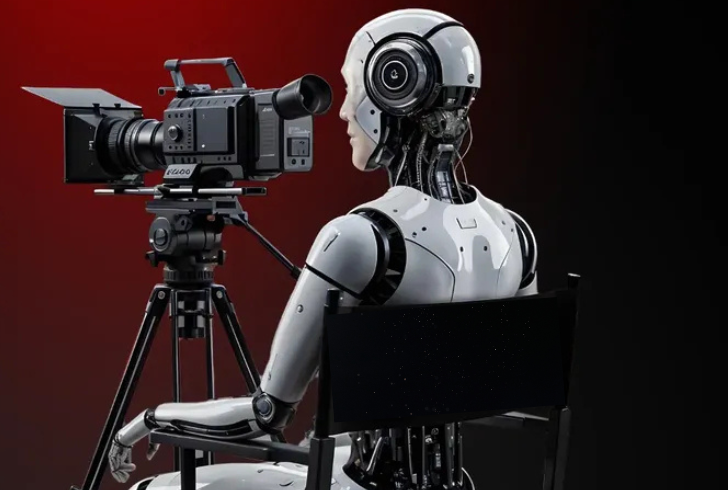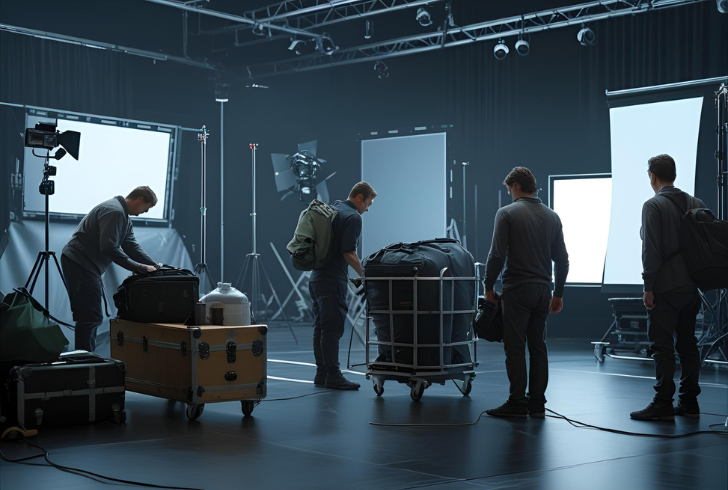Inside Hollywood’s AI Civil War and the Future of Filmmaking
As artificial intelligence continues to advance at breakneck speed, one industry facing a profound transformation is film. From production tools to full-on generative video, AI is pushing into every corner of Hollywood. But who’s steering the future—creative professionals or the machines themselves?
This article examines the current struggle for cinema’s soul, with studios, artists, and tech innovators all embroiled in a tug-of-war over automation, artistry, and ethics.
The New Creative Frontier
In an old studio building on the Eastside of Los Angeles, actress and producer Natasha Lyonne plays with a joystick that controls AI-generated images. The interface—part Atari paddle, part artistic experiment—is a glimpse into the future of filmmaking: humans collaborating directly with machines to generate creative content.
Lyonne, co-founder of AI startup Asteria, along with partner Bryn Mooser and filmmaker Craig Patterson, is helping develop Uncanny Valley, a film built entirely around machine-generated media. The project represents a growing movement—one that’s not arriving but is already here.
Startups like Asteria and Luma, industry giants like Google DeepMind and OpenAI, and curious filmmakers like Darren Aronofsky and James Cameron are all exploring AI as a creative partner. Meanwhile, AI tools like Sora, Gen-4, and Runway are being quietly tested inside major studios to reimagine production workflows.
A Full-On AI Insurgency Inside Hollywood

Instagram | @ftihfilmschool | AI steps behind the camera and changes who tells the stories.
The presence of AI in Hollywood is no longer experimental—it’s becoming systemic.
From indie films to major studio projects, AI tools are used to generate landscapes, simulate actors, and even create entire scenes without ever touching a real-world set. Companies like Runway AI have partnered with major names like Harmony Korine and AMC Networks, while tools like Luma’s Dream Machine allow creators to produce previously unimaginable visuals in seconds.
The goal of these tools? To create cinema from mere text prompts—or even tactile inputs—eliminating traditional bottlenecks like casting, location scouting, and visual effects teams.
AI offers scale and speed never before possible. As Luma’s CEO Amit Jain provocatively asked: “Why are you making five movies a year when you should be making 100?”
Creative Revolution or Existential Threat?
The excitement, however, is not without serious concern. Filmmakers and artists like Justine Bateman and concept illustrator Reid Southen argue that AI doesn’t “create”—it remixes and regurgitates the past. Bateman warns that AI removes the problem-solving and human ingenuity that have always defined great cinema.
She cites the iconic mirror shot in Sunset Boulevard—something invented, not prompted. “If they had AI,” she says, “we would have been robbed of one of the great shots in cinema.”
To these critics, using AI is not just an ethical issue—it’s an existential one. The fear isn’t that AI can’t make something impressive. It’s that what it produces lacks soul, originality, and connection.
From Documentaries to Blockbusters
Even films already in release show AI’s growing influence. At the Sundance Film Festival, Asteria premiered Free Leonard Peltier, a documentary that includes “recreations” generated entirely by AI. These scenes, from the perspective of the Native American activist trying to flee the FBI, look like traditional reenactments—but no one shot them.
This is the allure of AI: collapsing the boundary between imagination and execution. Need a cityscape? A robot uprising? A balloon-headed man floating through Paris? It can all be generated on command, as demonstrated in the whimsical Air Head, created using OpenAI’s Sora.
But these examples also highlight AI’s limitations. While they’re visually rich, many lack emotional depth and coherent storytelling. “The slop is just mind-blowing,” Aronofsky observed, “but none of it stays with you.”
The Budget Argument
One of the most powerful arguments for AI in filmmaking is economic.
Blockbusters like “The Electric State,” a Russo Brothers film filled with CGI and robot effects, cost more than $300 million to produce. AI could drastically reduce that figure. For indie creators, AI tools offer access to studio-level visuals. For studios, AI is a way to streamline production and avoid risk.
James Cameron, once an AI skeptic, now advocates using it to cut the cost of large-scale films in half. Aronofsky’s AI company, Primordial Soup, is also experimenting with new production pipelines.
Yet cost-saving alone may be a trap. If studios see AI as a way to flood the market with cheaper content, it could undermine the very infrastructure that enables high-quality human-made films.
Lawsuits and Legal Grey Areas
The legal battle is heating up. In 2024, Disney and Universal sued Midjourney, an image-generation company, for allegedly scraping copyrighted material to train its models. The lawsuit signals growing industry awareness that AI is feasting on decades of human creativity—often without permission or payment.
Interestingly, the studios themselves are in a bind. They want to save money using AI, but they also want to control and license their intellectual property. Courts in Los Angeles, where the lawsuit is filed, may be more sympathetic to Hollywood’s IP concerns than those in tech-friendly San Francisco.
Whatever the outcome, this case will likely shape the legal boundaries of AI-generated film for years to come.
The Problem of Originality
The biggest philosophical concern may be creative stagnation. If AI models are trained only on what already exists, and filmmakers use those models to create new films, the industry may be headed into a cultural ouroboros—repeating itself in increasingly shallow loops.
Screenwriter John Lopez sums it up: “There’s no way one dude at a keyboard has the creative impulses to put something on the screen that matches the information in 500 brains.”
Art evolves by building on the past while pushing into new territory. If AI constantly draws from the past but cannot transcend it, how do we get the next wave of originality?
Tools or Threats? It Depends Who Uses Them
Not everyone sees AI as a villain. Directors like Timur Bekmambetov are using AI as a narrative device. His film Luria will be filled with AI hallucinations—making the model’s flaws part of the plot. Similarly, Runway and Wonder Dynamics are building tools specifically for filmmakers, not to replace them.
Runway co-founder Cristóbal Valenzuela insists that the technology is just that: a tool. “They said the same about Industrial Light & Magic,” he argues, referencing the once-controversial rise of digital effects. Today, ILM is essential to modern storytelling.
But there’s a difference. ILM required artists, designers, and a huge team. AI can allow one person to bypass all of that. And that’s where the human cost begins.
The Labor Fallout

Image by Canva Ai. | Film workers feel the pressure as AI tools take over creative jobs.
Few industries match film in its level of collaboration. Lighting crews, set designers, concept artists, and costume makers all contribute essential work. Yet, today’s technology threatens each of these roles.
Reid Southen reports that studios have slashed his income as a concept artist by half—not because other artists took his place, but because studios no longer hire artists at all. Instead, they use tools like Midjourney and DALL·E to generate visuals instantly.
AI proponents often compare this shift to green screen technology, but the analogy doesn’t hold. Green screens expanded the possibilities of film production. In contrast, AI could reduce it—replacing crews of hundreds with just a few people typing prompts.
The Teamsters and other labor unions now demand strict regulations. SAG-AFTRA already secured AI protections in its latest contract, and the next WGA agreement will likely serve as a major battleground.
What’s Next? A Future Still Unwritten
For all the fear, there is also hope. Aronofsky, at the Tribeca Film Festival, presented Ancestra, a film produced using AI but with a deeply human story. His goal, he says, is to figure out how to inject emotion and narrative into machine-generated content.
He’s not alone. Many artists are trying to use AI with purpose, not as a shortcut but as a means to expand the cinematic language. Yet even they admit: no one has fully figured it out. And that’s what makes this moment so uncertain—and so exciting.
Will We Still Recognize Cinema?
The real question isn’t whether AI will make films—it already does. What matters now is what kind of films we’ll be left with.
Will it, for instance, empower new voices or flood the industry with soulless content? Could the next Moonlight or Parasite be written by a neural network? And more importantly, will the magic of cinema be replicated—or replaced?
At this crossroads, Hollywood must decide not just how to use AI, but why. If it chooses wisely, AI could become the next evolution in the cinematic art form. If not, the industry may find itself buried under a mountain of content—none of it worth remembering.